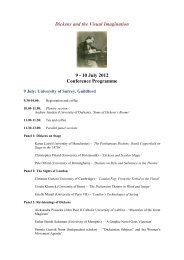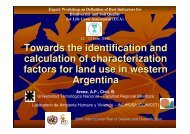The targeted killing of terrorists on foreign soil - Institute of Advanced ...
The targeted killing of terrorists on foreign soil - Institute of Advanced ...
The targeted killing of terrorists on foreign soil - Institute of Advanced ...
Create successful ePaper yourself
Turn your PDF publications into a flip-book with our unique Google optimized e-Paper software.
Tobias Ruettersh<str<strong>on</strong>g>of</str<strong>on</strong>g>f<br />
Panel 4 (a)<br />
such acti<strong>on</strong> complies with the principles <str<strong>on</strong>g>of</str<strong>on</strong>g> internati<strong>on</strong>al humanitarian law. On principle, the<br />
applicability <str<strong>on</strong>g>of</str<strong>on</strong>g> IHL has to be seen separate from the questi<strong>on</strong> <str<strong>on</strong>g>of</str<strong>on</strong>g> jus ad bellum (see Dinstein<br />
2005, 156 ff.). For IHL to apply, the existence <str<strong>on</strong>g>of</str<strong>on</strong>g> an armed c<strong>on</strong>flict is an indispensable<br />
prerequisite. <str<strong>on</strong>g>The</str<strong>on</strong>g>refore, it has first to be determined whether the internati<strong>on</strong>al fight against<br />
terrorism, including <str<strong>on</strong>g>targeted</str<strong>on</strong>g> <str<strong>on</strong>g>killing</str<strong>on</strong>g>, c<strong>on</strong>stitutes an armed c<strong>on</strong>flict.<br />
Although internati<strong>on</strong>al law does not provide a clear or uniform definiti<strong>on</strong> <str<strong>on</strong>g>of</str<strong>on</strong>g> ‘armed c<strong>on</strong>flict’,<br />
a quite precise understanding <str<strong>on</strong>g>of</str<strong>on</strong>g> it can be derived from the scope <str<strong>on</strong>g>of</str<strong>on</strong>g> applicability <str<strong>on</strong>g>of</str<strong>on</strong>g><br />
internati<strong>on</strong>al treaties, which have been c<strong>on</strong>cluded for situati<strong>on</strong>s <str<strong>on</strong>g>of</str<strong>on</strong>g> armed c<strong>on</strong>flict (see Melzer<br />
2009, 245). In its Tadic Case (1995, para. 70) the Appeals Chamber <str<strong>on</strong>g>of</str<strong>on</strong>g> the Internati<strong>on</strong>al<br />
Criminal Tribunal for the former Yugoslavia (ICTY) ruled that “an armed c<strong>on</strong>flict exists<br />
whenever there is a resort to armed force between States or protracted armed violence<br />
between governmental authorities and organised armed groups or between such groups<br />
within a state. Internati<strong>on</strong>al humanitarian law applies from the initiati<strong>on</strong> <str<strong>on</strong>g>of</str<strong>on</strong>g> such armed<br />
c<strong>on</strong>flicts and extends bey<strong>on</strong>d the cessati<strong>on</strong> <str<strong>on</strong>g>of</str<strong>on</strong>g> hostilities until a general c<strong>on</strong>clusi<strong>on</strong> <str<strong>on</strong>g>of</str<strong>on</strong>g> peace is<br />
reached; or, in the case <str<strong>on</strong>g>of</str<strong>on</strong>g> internal c<strong>on</strong>flicts, a peaceful settlement is achieved.” As<br />
menti<strong>on</strong>ed before, modern <str<strong>on</strong>g>terrorists</str<strong>on</strong>g>, who are organised in globally operating terrorist<br />
organisati<strong>on</strong>s, <str<strong>on</strong>g>of</str<strong>on</strong>g>ten employ military means to reach their goals. If severe combat activity<br />
arises in the fight against those <str<strong>on</strong>g>terrorists</str<strong>on</strong>g> it cannot be called a police activity any l<strong>on</strong>ger but<br />
must be c<strong>on</strong>sidered an armed c<strong>on</strong>flict (see Israeli Supreme Court 2002, para. 1). However,<br />
this does not clarify the applicability <str<strong>on</strong>g>of</str<strong>on</strong>g> IHL as there are different types <str<strong>on</strong>g>of</str<strong>on</strong>g> armed c<strong>on</strong>flicts<br />
and different regulati<strong>on</strong>s.<br />
Internati<strong>on</strong>al humanitarian law distinguishes between internati<strong>on</strong>al and n<strong>on</strong>-internati<strong>on</strong>al<br />
armed c<strong>on</strong>flicts (see Schmitz-Elvenich 2007, 168). Internati<strong>on</strong>al armed c<strong>on</strong>flict is regulated<br />
by the Geneva C<strong>on</strong>venti<strong>on</strong>s (GC) <str<strong>on</strong>g>of</str<strong>on</strong>g> 1949 11 (see ICRC 1949) and the Additi<strong>on</strong>al Protocol I<br />
(AP I) <str<strong>on</strong>g>of</str<strong>on</strong>g> 1977 (see ICRC 1977a), whereas n<strong>on</strong>-internati<strong>on</strong>al armed c<strong>on</strong>flict is regulated by<br />
Comm<strong>on</strong> Article 3 <str<strong>on</strong>g>of</str<strong>on</strong>g> the Geneva C<strong>on</strong>venti<strong>on</strong>s and Additi<strong>on</strong>al Protocol II (AP II) (see ICRC<br />
1977b). This dichotomy in internati<strong>on</strong>al and n<strong>on</strong>-internati<strong>on</strong>al armed c<strong>on</strong>flicts results from<br />
the traditi<strong>on</strong>al, territoriality-based, understanding <str<strong>on</strong>g>of</str<strong>on</strong>g> sovereignty and is particularly<br />
problematic in c<strong>on</strong>necti<strong>on</strong> with c<strong>on</strong>temporary ‘new c<strong>on</strong>flicts’ between a state and n<strong>on</strong>-state<br />
actors <strong>on</strong> <strong>foreign</strong> territory (see Bruha 2002, 414). Hence, there are two different possibilities<br />
for the applicati<strong>on</strong> <str<strong>on</strong>g>of</str<strong>on</strong>g> IHL <strong>on</strong> military measures against <str<strong>on</strong>g>terrorists</str<strong>on</strong>g> in a <strong>foreign</strong> state. On the<br />
<strong>on</strong>e hand, it would be c<strong>on</strong>ceivable to extend the noti<strong>on</strong> <str<strong>on</strong>g>of</str<strong>on</strong>g> internati<strong>on</strong>al armed c<strong>on</strong>flict from<br />
11 For the further analysis in this paper, <strong>on</strong>ly the Third Geneva C<strong>on</strong>venti<strong>on</strong> <str<strong>on</strong>g>of</str<strong>on</strong>g> 1949 (GC III) relative to the<br />
Treatment <str<strong>on</strong>g>of</str<strong>on</strong>g> Pris<strong>on</strong>ers <str<strong>on</strong>g>of</str<strong>on</strong>g> War is relevant.<br />
- 15 -
















